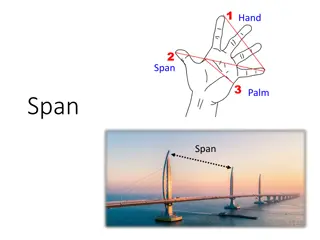Understanding Diagonalization in Linear Algebra
Discover the concept of diagonalization in linear algebra through eigenvectors, eigenvalues, and diagonal matrices. Learn the conditions for a matrix to be diagonalizable, the importance of eigenvectors in forming an invertible matrix, and the step-by-step process to diagonalize a matrix by finding independent eigenvectors and constructing the diagonal matrix. Explore the significance of eigenvectors forming a basis for R^n and the implications of diagonalizing a matrix.
Download Presentation

Please find below an Image/Link to download the presentation.
The content on the website is provided AS IS for your information and personal use only. It may not be sold, licensed, or shared on other websites without obtaining consent from the author. Download presentation by click this link. If you encounter any issues during the download, it is possible that the publisher has removed the file from their server.
E N D
Presentation Transcript
Diagonalization () Hung-yi Lee
Review If ?? = ?? (? is a vector, ? is a scalar) ? is an eigenvector of A ? is an eigenvalue of A that corresponds to ? Eigenvectors corresponding to ? are nonzero solution of (A In)v = 0 Eigenvectors corresponding to ? = ????(A In) ? eigenspace excluding zero vector Eigenspace of ?: Eigenvectors corresponding to ? + ? A scalar ? is an eigenvalue of A ??? ? ??? = 0
Review Characteristic polynomial of A is ??? ? ??? Factorization multiplicity ?1? ?2 ?2 ? ?? ?? = ? ?1 ?1 ?2 ?? Eigenvalue: ?1 ?? Eigenspace: (dimension) ?2 ?? ?1 ?2
Outline An nxn matrix A is called diagonalizable if ? = ??? 1 D: nxn diagonal matrix P: nxn invertible matrix Is a matrix A diagonalizable? If yes, find D and P Reference: Textbook 5.3
Diagonalizable (?) A2= 0 Not all matrices are diagonalizable If A = PDP 1for some invertible P and diagonal D A2= PD2P 1= 0 D2= 0 D = 0 D is diagonal A= 0 =0 =0 2 ?1 0 0 ?? =0 ?1 0 ?2= ? = 0 2 ?? =0
? = ?1 ?? Diagonalizable ?1 0 0 ? = ?? If A is diagonalizable = ?1?1 ???? ? = ??? 1 ?? = ?? ?? = ??1 ??? ?? = ? ?1?1 = ??1?1 ???? ????? = ?1??1 = ?1?1 ????? ???? ???= ???? ?? is an eigenvector of A corresponding to eigenvalue ??
? = ?1 ?? Diagonalizable ?1 0 0 ? = ?? If A is diagonalizable ?? is an eigenvector of A corresponding to eigenvalue ?? ? = ??? 1 = There are n eigenvectors that form an invertible matrix = There are n independent eigenvectors = The eigenvectors of A can form a basis for Rn.
? = ?1 ?? Diagonalizable ?1 0 0 ? = ?? If A is diagonalizable ?? is an eigenvector of A corresponding to eigenvalue ?? ? = ??? 1 How to diagonalize a matrix A? Find n independent eigenvectors corresponding if possible, and form an invertible P Step 1: The eigenvalues corresponding to the eigenvectors in P form the diagonal matrix D. Step 2:
Diagonalizable A set of eigenvectors that correspond to distinct eigenvalues is linear independent. ??? ? ??? Factorization ?1? ?2 ?2 ? ?? ?? = ? ?1 ?1 ?1 ?2 ?2 ?? Eigenvalue: ?? ?? ?2 ?1 Eigenspace: (dimension) Independent
Diagonalizable A set of eigenvectors that correspond to distinct eigenvalues is linear independent. ?2 ?1 ?1 ?? ?? Eigenvalue: Assume dependent ?2 Eigenvector: a contradiction vk= c1v1+c2v2+ +ck 1vk 1 Avk= c1Av1+c2Av2+ +ck 1Avk 1 kvk= c1 1v1+c2 2v2+ +ck 1 k 1vk 1 kvk= c1 kv1+c2 kv2+ +ck 1 kvk 1 0 = c1( 1 k) v1+c2( 2 k)v2+ +ck 1( k 1 k)vk 1 Not c1 = c2 = = ck 1= 0 ( k) - a contradiction Same eigenvalue
? = ?1 ?? Diagonalizable ?1 0 0 ? = ?? If A is diagonalizable ?? is an eigenvector of A corresponding to eigenvalue ?? ? = ??? 1 ??? ? ??? = ? ?1 ?1? ?2 ?2 ? ?? ?? ?1 ?2 ?? Eigenvalue: Eigenspace: Basis for ?3 Basis for ?1 Basis for ?2 Independent Eigenvectors You can t find more!
Diagonalizable - Example 1 0 0 0 0 2 1 = Diagonalize a given matrix 1 2 A characteristic polynomial is (t + 1)2(t 3) eigenvalues: 3, 1 A = PDP 1, where eigenvalue 3 0 1 1 0 1 1 1 0 0 0 1 = P B1= 1 eigenvalue 1 3 0 0 0 0 0 1 0 , 1 0 0 = 1 D B2= 0 1 1
Test for a Diagonalizable Matrix An n x n matrix A is diagonalizable if and only if both the following conditions are met. The characteristic polynomial of A factors into a product of linear factors. ??? ? ??? = ? ?1 Factorization ?1? ?2 ?2 ? ?? ?? For each eigenvalue of A, the multiplicity of equals the dimension of the corresponding eigenspace.
Independent Eigenvectors An n x n matrix A is diagonalizable = The eigenvectors of A can form a basis for Rn. = ??? ? ??? ?1? ?2 ?2 ? ?? ?? = ? ?1 ?1 ?1 ?2 ?2 ?? Eigenvalue: ?? = ?? = ?2 = ?1 Eigenspace: (dimension) ?1+ ?2+ + ??= ?
Application of Diagonalization If A is diagonalizable, ? = ??? 1 ??= ???? 1 Example: .15 Study IG .85 .97 .03 .85 .85 Study Study Study .15 .03 .85 .727 .15 IG IG .97 .273 .15
From Study IG .15 Study IG .85 .97 To Study .03 IG = ? .85 .85 Study Study Study .15 .03 .85 .15 .727 IG IG .97 .273 .15 .727 .273 1 0 .85 .15 ? = ??? 1 ??= ???? 1
Diagonalizable Diagonalize a given matrix 1 = 1 p 1 RREF 1 (invertible) = p 2 5 RREF
When ? , The beginning condition does not influence. 1/6 5/6 1/6 5/6 ??= 1/6 5/6 1/6 5/6 1/6 5/6 1/6 5/6 1/6 5/6 1/6 5/6 1 0 0 1 = =
Diagonalization of Linear Operator ?1 ?2 ?3 8?1+ 9?2 6?1 7?2 3?1+ 3?2 ?3 Example 1: ? = det -t 8 9 0 0 The standard matrix is ? = -t 6 3 7 3 -t 1 the characteristic polynomial is (t + 1)2(t 2) eigenvalues: 1, 2 Eigenvalue -1: Eigenvalue 2: B1 B2is a basis of R3 T is diagonalizable. 1 1 0 0 0 1 3 B1= B2= , 2 1
Diagonalization of Linear Operator ?1 ?2 ?3 ?1+ ?2+ 2?3 ?1 ?2 0 ? = Example 2: -t 1 1 0 1 2 0 0 det The standard matrix is ? = 1 0 -t -t the characteristic polynomial is t2(t + 2) eigenvalues: 0, 2 the reduced row echelon form of A 0I3= A is ?1 ?2= 0 ?3= 0 ?3 1 0 0 1 0 0 0 1 0 ?1 ?2 1 1 0 = ?1 the eigenspaces corresponding to the eigenvalue 0 has the dimension 1 < 2 = algebraic multiplicity of the eigenvalue 0 T is not diagonalizable.
Review Simple Function Another coordinate system output Input Cartesian coordinate system Input Output Complex Function
Flowchart ?B ?B ? ?B B coordinate system ? ? 1 Cartesian coordinate system ? ? ? ? ? = ? ?B? 1 ?B= ? 1? ? similar similar
Example: reflection operator T about the line y = (1/2)x 0.4 0.2 0.2 0.4 ? =2 1 2 ? 1= ?2= 1 1 y = (1/2)x 2 ?B ?B ? ?B ?1=2 1 0 0 1 1 ? 1 ? y = (1/2)x ?2=0 ? =? 1 ? ? ? ?1=1 0 ? = ? ?B? 1
Diagonalization of Linear Operator Reference: Chapter 5.4 ?B ?B ? ?B simple ? 1 ? Properly selected Properly selected ? ? ? ?
Diagonalization of Linear Operator If a linear operator T is diagonalizable ?B ? ?B ? ?B simple Eigenvectors form the good system ? 1 ? 1 ? ? Properly selected Properly selected ? = ??? 1 ? ? ?
Diagonalization of Linear Operator -1: 2: ?1 ?2 ?3 8?1+ 9?2 6?1 7?2 3?1+ 3?2 ?3 3 1 1 0 0 0 1 B2= ? = B1= 2 1 , ?B ?B ? ?B 1 0 0 0 0 0 2 1 0 1 1 1 0 0 0 1 3 1 1 0 0 0 1 3 2 1 2 1 8 9 0 0 6 3 7 3 1 ? ? ?























